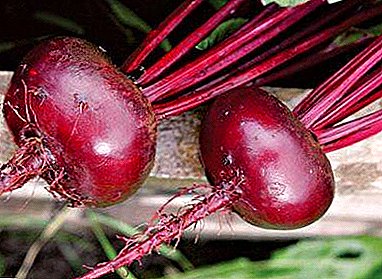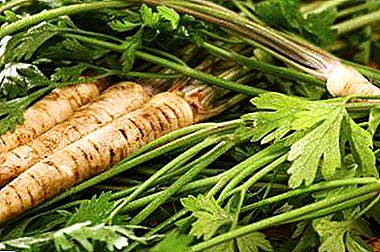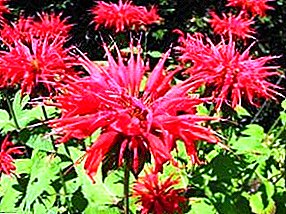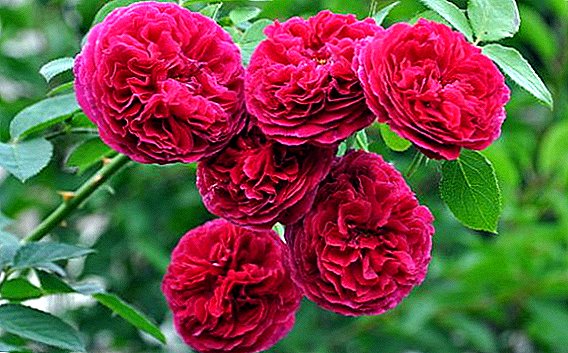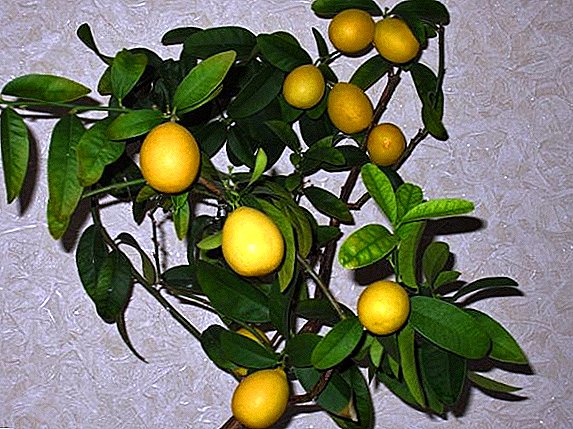 If you have already encountered in the flower shop with the unusual name of a plant limonella or limequat, but did not dare to buy it, then know that this is not just a marketing ploy, but an independent citrus plant that lives well at home. About his growing at home, we will tell.
If you have already encountered in the flower shop with the unusual name of a plant limonella or limequat, but did not dare to buy it, then know that this is not just a marketing ploy, but an independent citrus plant that lives well at home. About his growing at home, we will tell.
Botanical description
Limequat (limonella) was bred by crossing Mexican lime with Japanese kumquat in 1909 in China, according to other sources - in Florida. Three plant species are described: Lakeland (Lakeland), Eustis (Eustis) and Tavares (Tavares).
Citrus - a real storehouse of vitamins for our health. They also include: grapefruit, pomelo, Poncirus trifoliata (Poncirus trifoliata), orange, suite, lemon, kumquat, calamondin, tangerine and citron.This fruit belongs to citrus, in appearance similar to an elongated lemon, small, it smells like lime. Outside it is covered with a thin peel of light green, yellow green or light orange color, it tastes sweet, inside is a juicy flesh of bitter-sweet taste with a few bones. Fruiting tree abundantly, ripe fruits can be collected in early autumn.

Did you know? Citrus trees are long-lived, they can live up to 700 years.The tree is low, covered with dark brown bark and prickles, branched, not more than 2.5 m high. The leaves are shiny, fleshy, green, oblong, pointed at the tips.
The flowers are white, in Tavares - pink, bloom in late winter-early spring.
Spread
The most common limequat in South Africa, Israel, Britain, Malaysia, Armenia, Japan, Spain, the United States. 
Chemical composition
Calorie limonella is 20 kcal per 1 fruit. It contains fats and proteins in a small amount, there are 7 g of carbohydrates, 2 g of dietary fiber, 54 g of water. The peel of citrus contains manganese, molybdenum, iron and copper, in the pulp - potassium, calcium and phosphorus. Most in limequate vitamin C, there are vitamins A, E, PP, B5, B4.
Beneficial features
The benefits of limequat are as follows:
- contributes to the body's fight against viruses;
- useful in cardiovascular diseases;
- relieves fatigue;
- improves metabolism;
- favorably affects the work of the nervous system;
- promotes the absorption of iron;
- protects against environmental hazards;
- provides a good mood.
As well as limonella, in diseases of the cardiovascular system, the following plants are also used: carrots, radishes, calendula, hawthorn (glod), silver goof, basil, eggplants, aconite, filbert, gumi (many-flowered mulberry) and yasenets (burning burner).

Application of limonella
With the help of limequat, representatives of alternative medicine treat various diseases, it is used by cosmetologists and cooks. In addition, the plant can serve as a good decoration of your home or garden.
In folk medicine
Traditional medicine uses limequat to:
- relief of migraine;
- relieving pain from nerve inflammation;
- prevention of diseases of the gastrointestinal tract;
- inhalation of colds;
- good night.
In addition to limonella, with problems with digestion, bathing, calendula, sage (salvia), meadow grass, linden, chervil, lyubka double, cress, yucca, dodder, viburnum buldenege, goldenrod, slizun, peanut, oregano (oregano) are also used: and cabbage kale.

In cosmetology
Beauticians on the basis of limonella make means:
- tonic lotions;
- anti-wrinkle masks;
- skin softening oils;
- to relieve inflammation on the skin;
- preparations for removing warts;
- creams for tired skin.
In cosmetology, they also use momordica, purslane, marigolds, nasturtium, leek, bird cherry, rosemary, cornflower, broccoli, garden savory, soapworm (saponaria), honey and lime.

In cooking
Limequat can be added to any dish instead of lemon or lime, but due to its more intense flavor, it is added in smaller quantities.
With the help of a special citrus juicer, you can squeeze out juice from it and drink it, mixing it with other juices. Based on it, you can make stuffing, cocktail, cream, meringue or soufflé, you can sprinkle them on peeled apples so that they do not darken.
Did you know? Often, lime is considered a hybrid of lemon, but this is fundamentally wrong, because it was already already green on the lands of Asia, when it was never heard of lemon.

The peel is suitable for making candied fruit and peel. The flesh together with the peel is suitable for candied slices, from the pulp of limequat and other fruits you can make a fruit salad. The original taste will have a jam from limonella.
This citrus is suitable not only for desserts, but also for preparing meat sauce, roasting fish or poultry.
In gardening
By planting a limequat, you can decorate not only the room, but also the area near the house. This tree looks good, even if the flowering period has not yet come or is already over. It is resistant to cold, gives a generous harvest, starts to bear fruit early and is not picky in care. However, it is necessary to plant it in special containers, and not in open ground - it will not be able to spend the winter on the street limonella. 
Growing a limequat
Limekvat is not very demanding to care, but to improve the yield and appearance of the plant, read some recommendations regarding the care of him.
Choice of location and lighting
Limonella loves an abundance of light, like other citrus fruits. It is best to have it on the east or west window, on the south you need to shade the plant at the peak of the solstice to protect the foliage from burns. 
In winter, the plant is recommended to highlight with a lamp to ensure light for 12 hours, otherwise the leaves will become pale, begin to dry around the edges and fall off. Although the plant does not die, the leaves grow back in the summer.
Laymkvat maintains temperature to +10 ° C, the upper limit makes +30 ° C. Plants planted in the area near the house should be brought into the room for the winter, they will not survive the frost.
Important! If the air temperature drops to +5 °C, leaves will fall off the plant.
 At home, limequat is usually low, so it can be planted in a small pot. Take care to keep the plant away from drafts.
At home, limequat is usually low, so it can be planted in a small pot. Take care to keep the plant away from drafts.Substrate and fertilizer
Laymkvat need to be planted in the soil with a neutral level of acidity. Improved soil structure will help added to it:
- sand (at the rate of 1 to 10);
- ash (1 teaspoon for a glass of soil).

Land for planting can be gathered in the park away from coniferous trees, chestnut and oak. In the upper layer of such soil a lot of biohumus. To improve its structure, add:
- sand - at the rate of 1 to 2;
- humus - 1.5 tablespoons per cup of earth;
- ash - 1 teaspoon per glass.

At the bottom of the pot should definitely put drainage. Top ground can be compounded with compost.
If you want to protect the plant from possible natural troubles, find out why you need soil mulching, especially the reception of agrotechnical reception.Peel soil from a flower shop is not suitable for a limequat - it has a high acidity.
A month after planting, there are no nutrients left in the ground, so the plant needs to be fed. You can buy special preparations for citrus in the store. From homemade fertilizers recommend these:
- 1 spoon of ash dissolved in 1 liter of water;
- ordinary tea brew;
- finely chopped quinoa, bathed in water and infused day.
 Finely chopped quinoa
Finely chopped quinoaYou can also put 0.5 liters of limewood in a one-liter jar, pour water to the edge, stir, infuse for 2 days. Further, this means fertilize the plant.
Top dressing is carried out 1 time in 10 days in the period from the beginning of flowering to the end of fruiting, be sure to water the soil before.
Important! Do not fertilize limequat immediately after transplantation, in the winter, and if he gets sick.
Planting and breeding
After buying a limequat, as well as when it exceeds the double height of the pot, a transplant should be carried out. The best time for this is mid-February. Transplantation requires special care, the plant is transplanted along with the ground in which it grew, without straightening and not washing the roots.  It is possible to propagate limonella by seed or cuttings, however, the first method is more troublesome and requires vaccinations for fruiting.
It is possible to propagate limonella by seed or cuttings, however, the first method is more troublesome and requires vaccinations for fruiting.
- On the cuttings fit those trunks that have already become partially woody, not younger than six months old. Cuttings can also be prepared in the process of cutting the plant.
- Cut the stalk with three to four leaves, cut the bottom sheet. From below, the stem is cut diagonally, from above - straight. With the help of a needle, small scratches are made on the bottom of the bark;
- Drainage is poured into a small pot, the prepared soil is planted and a cutting is planted along the level of the second leaf, then watered and covered with a can, bottle or plastic bag. This shelter periodically needs to be lifted to provide access to fresh air.
- You should not water the cuttings too often, otherwise the roots will rot. Optimally - after the appearance of the first leaves, but if the earth has dried before, then you can water.

Watering and moisture
Limekvat does not tolerate excess moisture, it dies, so you need to follow the rule: do not water the plant until the ground in the pot feels dry on the touch. At the same time, the amount of water for irrigation should be such that the whole earth is soaked to the bottom.
The tree tolerates dry air well, but in the winter in some apartments the humidity becomes critically low. Some spray water around the plants, but this can cause them to rot. To increase the humidity, you can put flat stones on the bottom of the vessel and pour water to the middle of their height. Pot with limonella put on the stones, making sure that it does not touch the water. 
Diseases and pests
Limequat is prone to these diseases:
- Chlorosis - yellow spots appear on the leaves, the leaves begin to fall. Caused by improper fertilization or insect exposure. It is necessary to cut off the diseased leaves, treat the shoots with a soap solution, find out the cause of the disease and fight it.
- Malsecco - drying out caused by fungus. Often applies to plants planted near the house on the leeward side. There is no way to fight; only preventive actions are possible, such as fungicide treatment.
 Chlorosis on limequat leaves
Chlorosis on limequat leavesDid you know? Kumquat in China is called the golden apple, and in Japan - the golden orange.
Pests affecting limequat are:
- Worms: fluffy, waxy, soft, mealy - small worms eating a plant. At home, you can insist grated onions in 0.5 liters of water for 2 days and process the wood.
- Shchitovka red. You may find drops of dirty brown. A means of combating them is soap suds or store chemistry ("Aktara", "Bankol").
- Pliers red and silver - a thin web appears on the leaves, white scurf. To combat use onion or garlic tincture, you can purchase store tools ("Neoron", "Actofit").
- Aphids are small green or black fleas that drink juice from a plant. Fight them with onion, garlic tincture, soap suds or chemicals ("Fitoverm", "Akarin").

Harvesting and storage of raw materials
The ripening time of limonella is the beginning of September. The ripe fruits of the limequat fall, but if this does not happen, they can be picked by hand. Then they should be washed, dried with a paper towel and stored in the refrigerator for no longer than 3 weeks. Up to 6 months, it is possible to extend the shelf life of fruits, if they are frozen at a temperature not lower than -18 ° C.
The fruit can be removed and dried zest, without access of moisture, it can be stored for up to 1 year. Use it in desserts or add to tea for flavor. 
Cooked limequat jam can be stored in a dark room for up to 1 year. The same will be stored harvested juice of limonella, but for this it is necessary to bring to a boil, and this will destroy most of the vitamin C.
As you have already seen, limequat can take a worthy place in your home flower garden and decorate any part. It is easy to care for him, if you do not forget to provide enough light and watering as needed, and the harvest will be useful not only for food, but for treatment.
Limequat Online Reviews
A small tree is grown as a container plant in the form of a bush. There are three varieties of limequat, which appeared as a result of various crosses of Citrus aurantifolia x Fortunella. They were bred in the USA, in Florida and named Lakeland, Eustis, Tavares in honor of the cities of the state.
All varieties of limequat are very decorative, but they have gained popularity not only by their spectacular appearance. The plant is not afraid of frosts, very fruitful and begins to bear fruit at an early age. Small-sized, oval or elongated, greenish-yellow or yellow limequat fruits have the characteristic aroma of lime. The rind is thin, sweetish taste, but the fruit is sour.
CARE: Unlike some citrus varieties in the care of limequat is not difficult, not fastidious plant. It is important that he had enough light, moderate watering and timely feeding, especially in summer and when fruiting. Grow as a rule in the form of a bush, because The limequat starts branching from a small age and size.
APPLICATION: Widely used in cooking. Lemonella oil has a reputation as a means to clarify thoughts, and therefore helps with headaches, migraines, neuralgia.

The fruits look like this: Small, cute, dried peel, soft, fragrant, without a white bitter layer, like lime. The aroma of limequats is thinner than that of limes, a bit nobler, closer to kumquats. The taste is sour, like that of lemon or lime, but not so sharp, 3-4 seeds per fruit. In general, nothing special! Well served in baking, in tea, in marinades ... Yes, wherever you can use lime or lemon ... I would even buy it often and even with pleasure, but on condition that the price be at least 200 rubles per kg., And so ... unlikely to buy more. I want to try to plant a couple of seeds, suddenly grow in the room. At least in the shops, pots with fruiting limonella are sold here.
In general, I recommend the fruit, but I lower the estimate for the cost!



